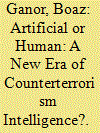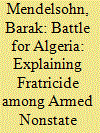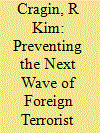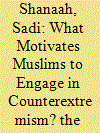|
|
|
Sort Order |
|
|
|
Items / Page
|
|
|
|
|
|
|
| Srl | Item |
| 1 |
ID:
179977


|
|
|
|
|
| Summary/Abstract |
A new revolution has begun in counterterrorism—the Artificial Intelligence (AI) revolution. The AI revolution has had a significant impact on many areas of security and intelligence. The use of AI and big data in general, and in the field of intelligence and counterterrorism in particular, has led to intense debates between supporters of the continuation and expansion of the use of this technology and those who oppose it. The traditional delicate balance between effectiveness in the fight against terrorism and the liberal democratic values of society becomes even more crucial when counterterrorism engages in AI and big data technology.
|
|
|
|
|
|
|
|
|
|
|
|
|
|
|
|
| 2 |
ID:
179985


|
|
|
|
|
| Summary/Abstract |
Unity among a rebel movement is associated with positive returns, yet rebel groups often fail to come together and even fall into fratricide infighting. Focusing on a rebel field in which one group enjoys primacy, I present three pathways that are likely to produce rebel fratricide: first, power shifts within the rebel movement; second, spillover from internal conflict within the dominant group; and third, disagreements over targeting noncombatants. I explore the role these mechanisms played in fratricidal violence among the Islamist opposition in Algeria during the 1990s civil war.
|
|
|
|
|
|
|
|
|
|
|
|
|
|
|
|
| 3 |
ID:
179981


|
|
|
|
|
| Summary/Abstract |
Ananda Marga (AM) was established in India in 1951, and was over time involved in political violence there. Its leader was arrested in 1971 and AM banned in 1975. By then it had spread globally, with AM groups set up in Australia and New Zealand in the early 1970s all peacefully disposed. The 1975 banning of the sect in India led to a change in AM behaviour globally, with the first act of AM terrorism outside of India attempted in New Zealand that year. AM acts of terrorism occurred subsequently in Australia. There were significant links between AM in both countries, but Australia and New Zealand chose individual national approaches over a coordinated response to AM terrorism. These approaches were not always effective and at times actually counter-productive. This case study considers the limitations of CT tactics used at the time, some of which are still used today.
|
|
|
|
|
|
|
|
|
|
|
|
|
|
|
|
| 4 |
ID:
179978


|
|
|
|
|
| Summary/Abstract |
In recent years there has been the proliferation of counterradicalization programs that incorporate a case management approach involving individually tailored intervention plans. The evaluation of case-managed countering violent extremism (CVE) interventions is challenging. This article provides results from research that evaluated a custody-based case-managed intervention delivered to convicted terrorists and individuals identified as at risk of radicalization in the Australian state of New South Wales, called the Proactive Integrated Support Model. A quantitative assessment of disengagement based on the coding of client case note data is provided. Results provide data on the background of clients, their intervention goals, and illustrate client change over time. Lessons for CVE evaluation and the role of formal interventions in facilitating disengagement are highlighted.
|
|
|
|
|
|
|
|
|
|
|
|
|
|
|
|
| 5 |
ID:
179980


|
|
|
|
|
| Summary/Abstract |
Palestinian women have played an increasingly active role in terrorist activities in the past two decades as part of the Israeli–Palestinian conflict. The present study aims to examine differences in the characteristics of female Palestinian terrorists and in the patterns of their terrorist activity between the Second Intifada and the Third Intifada. Furthermore, a comparative analysis of male Palestinian terrorist activity between the two Intifada periods was conducted in order to explore whether trends in female terrorist activity were unique to women or reflected global trends. Data are based on 171 female and male Palestinians that carried out terrorist activities. The findings show that age, terrorist method and organizational affiliation correlate significantly with the Intifada period. Significant differences were not found in the main motive for female terrorist activity. The analysis shows that overall trends of Palestinian female terrorist characteristics and their involvement in terrorism were similar to those of male terrorists. Moreover, during the Third Intifada female terrorists mainly acted alone, reflecting the current growing global trend of lone-actor terrorists.
|
|
|
|
|
|
|
|
|
|
|
|
|
|
|
|
| 6 |
ID:
179983


|
|
|
|
|
| Summary/Abstract |
The majority of scholarship on chemical, biological, radiological, and nuclear (CBRN) terrorism relies on non-empirical theorizing or the in-depth examination of a handful of prominent cases. A key reason for the dearth of systematic analyses is the lack of a comprehensive database on CBRN terrorism events amenable to quantitative analysis. This article introduces the Profiles of Incidents involving CBRN and Non-State Actors (POICN) database, consisting of 517 CBRN terrorism–related events from 1990 to 2017. After laying out the general scope of the database and its unique approach to incident validation, the article illustrates POICN’s potential through preliminary observations of the data.
|
|
|
|
|
|
|
|
|
|
|
|
|
|
|
|
| 7 |
ID:
179974


|
|
|
|
|
| Summary/Abstract |
Foreign terrorist fighters (FTFs) signify a unique threat. Islamic State leaders recruited many of them specifically to conduct terrorist attacks against the West. Many of these external operations have proven to be sophisticated and deadly, such as the November 2015 attacks in Paris. Yet the threat posed by FTFs goes beyond orchestrating attacks. In the past, they returned home to build networks that, in turn, facilitated a new generation of FTFs. Even more challenging, today’s FTFs can interact with recruits on social media to inspire attacks. This article addresses the threat of a new wave of FTFs and potential countermeasures. It presents findings from a comparative analysis of Tunisia and Algeria, concluding that to reverse the compounding nature of FTFs, countries must identify the potential threat from the outset, put appropriate legal measures in place, adequately fund judicial systems, and institute re-integration programs.
|
|
|
|
|
|
|
|
|
|
|
|
|
|
|
|
| 8 |
ID:
179975


|
|
|
|
|
| Summary/Abstract |
This article attempts to fill a gap in research on the propaganda methods exploited in the Islamic State’s flagship online magazines, Dabiq and Rumiyah. Its major objective is to discover methods exploited by their editors either to convince readers to join the ranks of the Islamic State, or to partake in jihad in the form of violent actions against infidels. The article also attempts to understand the magazines’ modus operandi in terms of legitimizing the “Caliphate’s” violence against its enemies. In order to reach these goals, content analysis and comparative analysis were utilized. This article argues that while the legitimization of violence and call to violence was strongly emphasized in both magazines, there are significant differences in terms of recruitment messages. On the one hand, Dabiq prioritized this issue (e.g., through the promotion of hijrah). On the other hand, Rumiyah was much less interested in inciting followers to join its ranks in the Middle East. Instead, it focused on calling Ummah to participate in jihad against the infidels, especially in the form of lone-wolf terrorist attacks.
|
|
|
|
|
|
|
|
|
|
|
|
|
|
|
|
| 9 |
ID:
179976


|
|
|
|
|
| Summary/Abstract |
This article investigates the role religious beliefs play in leading European Muslims to justify terrorism, using survey data collected in twenty-one countries. Results show that the factors leading Muslims to justify terrorism contextually vary. Where Muslims are predominant, this probability decreases with the importance respondents assign to religion, while it increases where Muslims are a minority. We find no evidence in support of the thesis that Islamist propaganda causes ordinary believers’ radicalization. Yet, in Western countries affected by homegrown terrorism, we observe that justifying terrorism is strongly associated with an increase in religious practice, providing support to the thesis that Islamist groups are attracting Islam radical individuals.
|
|
|
|
|
|
|
|
|
|
|
|
|
|
|
|
| 10 |
ID:
179982


|
|
|
|
|
| Summary/Abstract |
Although recent years have seen a great increase in the study of hate crime and terrorism, there is limited research to date that explores connections between hate crime and terrorism. This study uses a qualitative case-study method to explore the competing criminological theories of social learning and social control to investigate their utility in explaining radicalization among hate and terrorist violent extremists. Our analysis demonstrates important similarities and differences across ideology and offender types in their career pathways. We find support for the use of an integrated social control–social learning model to explain radicalization and the commission of extremist violence.
|
|
|
|
|
|
|
|
|
|
|
|
|
|
|
|
| 11 |
ID:
179979


|
|
|
|
|
| Summary/Abstract |
The article analyzes more than twenty years of evidence on electoral violence as reported by Organization for Security and Cooperation in Europe (OSCE) monitoring mission reports. It identifies prevailing trends of electoral violence in the OSCE participating states in order to better understand how the phenomenon is understood and framed by the leading international monitoring organizations in the region. The analysis utilizes a unique approach based on automated content analysis employing counting algorithms and latent semantic indexing. The results of the analysis show how electoral violence differs throughout the region while highlighting the qualitative variations in regional patterns of the reported incidents of election-related violence.
|
|
|
|
|
|
|
|
|
|
|
|
|
|
|
|
| 12 |
ID:
179984


|
|
|
|
|
| Summary/Abstract |
Western governments increasingly encourage Muslims to challenge Islamist extremism. However, the dominant academic and public discourse regards Muslims as deeply alienated and thus reluctant to do so. The article investigates motivations for Muslim counterextremism engagement and based on that formulates policy recommendations that are useful to government agencies that seek to mobilize Muslim communities to fight Islamist extremism. The analysis finds that Muslims are more likely to mobilize if governments highlight how Islamist extremism violates Islamic and universal values, how it negatively affects particular sections of Muslim communities, and how it can be successfully tackled by Muslim-based action.
|
|
|
|
|
|
|
|
|
|
|
|
|
|
|
|
|
|
|
|
|